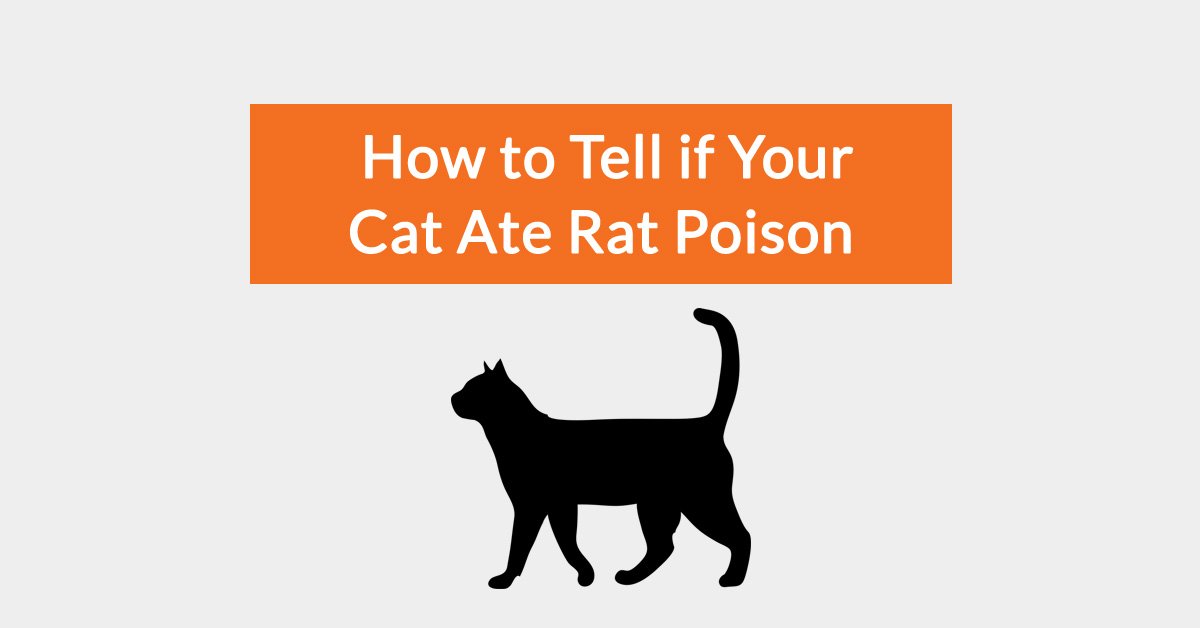
How To Tell If Your Cat Ate Rat Poison

Rats and mice are not only a major nuisance, but they can transmit disease and cause serious illness. When signs of rats or mice appear, most homeowners will not waste any time addressing the problem. Often, people turn to the most widely used methods — believing it is a quick an easy way to tackle a rat infestation. Snap traps and glue traps often come to mind, but rodenticides are also a very popular choice for many people in this situation.
Rodenticides may seem like a good option: Rats will eat the poison and go off and die. Many people don’t realize these rodenticides come with some very serious consequences — especially for wildlife and pets. Any pet owner would agree, the safety of your pet comes first. Cats are a primary concern, due to their tendency to hunt rodents.
It’s important to know the signs and symptoms of rodenticide poisoning in your cat. Even if you are not using a rodenticide, a neighbor may be. If you have an outdoor cat, there is always a possibility your cat was exposed to a rat or mouse poisoned by rodenticide.
If you think your cat has ingested rat poison, it is very important to see a vet immediately. There are varying symptoms depending on the rodenticide, but here are the most common signs to look out for:
- Bruising easily
- Bleeding or pale gums
- Blood in urine, feces or vomit
- Weakness or lethargy
- Staggering or walking with a gait
- Labored breathing, which can signal blood accumulation in the chest
- An enlarged abdomen, which could be an accumulation of blood
Seek medical treatment from the nearest vet immediately, or call Poison Control right away if you suspect your cat has eaten rat poison. Numbers to call are:
Poison Control: 1-(800)-222-1222
The Pet Poison Helpline: (855) 764-7661

Below are different types of rodenticides and their symptoms to help better understand which your cat may have come in contact with.
Bromethalin
Rodenticides containing Bromethalin cause swelling of the brain. These rodenticides should not be mistaken for ACR (brodifacoum, bromadiolone, etc.). Bromethalin poisoning doesn't clot the blood so it can't be treated by using Vitamin K1. Symptoms generally develop within 2 hours but may take up to 36 hours to appear.

Some brands containing Bromethalin are: Bell, Neogen, Montomco
Common Symptoms:
- Lethargy
- Anxiety
- Tremors/shaking
- Decreased appetite
- Impaired movement and coordination
- Paralysis of the hind legs
- Vomiting
- Seizures
- Possibility of death or coma
Treatment
Possible treatments include induced vomiting, activated charcoal and an osmotic cathartic to empty the cat's bowls, and IV fluid flushing. Anti-seizure and muscle-relaxants may also be prescribed by your vet. Treatment can take up to several weeks.
ACR (Anticoagulant Rodenticides)
This poison prevents blood clotting and causes internal bleeding. It may take 3-5 days for symptoms to appear unless you cat has been chronically exposed, in which case symptoms are usually noticeable much sooner.

Some brands containing ACR toxins are: Bell, Generation, JT Eaton, Final Strike, Rodex, Havoc, Talon
Most Common Symptoms:
- Lethargy
- Collapsing/Weakness
- Difficulty breathing
- Coughing with or without blood
- Pale or bleeding gums
Less Common:
- Vomiting with or without blood
- Diarrhea with or without blood
- Swollen joints
- Nose bleeding
- Blood in urine
- Bodily bruising
- Possible death
Treatment
Vitamin K1 prescribed by your vet is the best treatment for this type of poisoning. Most cats will need to take vitamin K1 for up to 30 days after ingesting ACR. Over-the-counter medications and food supplements with vitamin K1 will NOT treat this type of poisoning. Only prescription K1 will work.
Cholecalciferol (Vitamin D3)
Cholecalciferol is one of the most dangerous poisons and even a small amount can be lethal. Cholecalciferol poisoning is costly and very difficult to treat. This type of poisoning is often very challenging for vets to treat in cats and other animals.

Some brands containing Cholecalciferol are: d-Con, Quintox, Montomco, Bell
Common Symptoms:
- Lethargy and weakness
- Decreased appetite
- Increased thirst and urination
- Noticeably bad breath
- Tremors/shaking
- Possible kidney failure and death
Treatment
An antidote is not available but for the best possible outcome, aggressive IV fluid injections are used to flush the kidneys. This should return the calcium levels back to normal. Cats usually need to be hospitalized for up to a week.
Phosphides
These rodenticides are most commonly used to kill larger rodents such as moles and gophers. This poison is less common, but it produces a toxic gas in the stomach of your cat that can potentially harm humans. If vomited in a non-ventilated area, inhaling the toxic fumes can cause lung-irritations of anyone breathing the fumes.

Some brands containing Phosphides are: Montomco, Prozap
Common Symptoms:
- Drooling excessively
- Stomach bloating
- Abdominal pain
- Collapsing/Weakness
- Seizures
- Vomiting
- Possibility of liver damage
Treatment
After ingesting Phosphides, it is very important to keep your cat from eating other food. Food consumption increases the toxic gasses in the stomach, which can intensify the poison. Professional treatment should be sought immediately since there are no specific antidotes for rodenticide poisoning. Other treatments include may inducing vomiting, stomach pumping, antacids, or fluid flushing with an IV.
How To Prevent Rat Poisoning

There are a few things you can do to prevent your furry friends from getting into the poison traps in the first place! Consider these precautionary steps before you decide if and where to use rodenticides.
1. Avoid using rodenticides.
There are many safe, non-toxic alternatives to rat poison. The best way to protect your pets from rat poison is to use safe methods of rodent control.
2. Mouse traps should always be placed out of reach of your pets.
This can be challenging with cats, who are curious and able to grab things with their mouths or paws. Think of a cat when securing the traps and ask yourself if they will be able to find a way to get to the trap.
3. Enclosing your rat poison in a cage is one alternative.
Any cage around your trap needs to be large enough for rats to enter, but too small for cats.
4. Monitor your cat.
Always keep a close eye on your pet. Cats are very curious creatures — whether inside or outside.
If your cat's behavior changes for an unknown reason, make an appointment with your vet as soon as possible. If you think your cat has been exposed to any of the rodenticides above, you should seek treatment with your vet immediately.
A Safe Alternative
Goodnature's A24 Automatic Rat & Mouse Trap is non-toxic and safe around children and pets. Visit the Goodnature collections page to shop and learn more about our products
- Choosing a selection results in a full page refresh.
!

